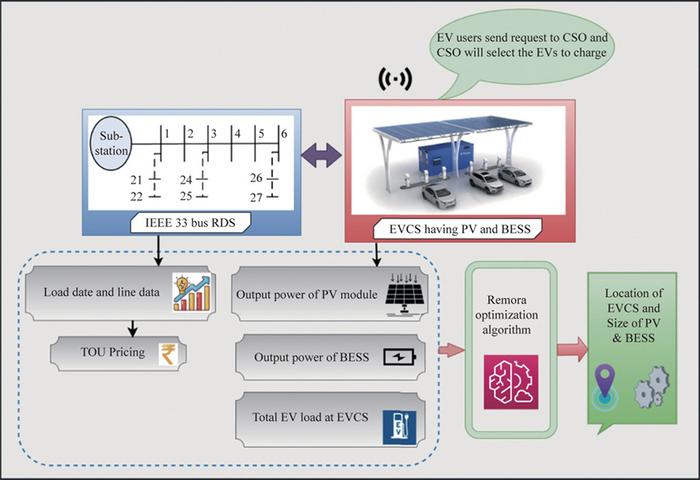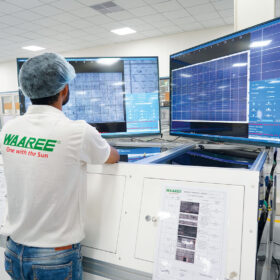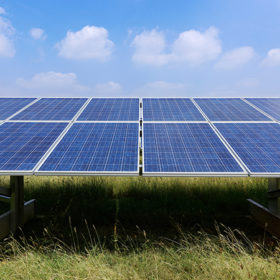A group of scientists from India has developed a novel method for the scheduling of the charging of electric vehicles (EVs) in charging stations that include PV generation and battery energy storage systems (BESS).
The proposed method consists of two components: optimization and hierarchization. The first component optimizes the placement of EV charging stations (EVCS) within a standard IEEE 33-bus radial distribution system, along with the sizing of the PV system and the BESS. The second component determines the order in which EVs are charged.
“This research tackles the chaos by optimizing station placement and operations in distribution networks, ensuring efficient power flow while curbing emissions and expenses,” the team said in a statement. “By addressing these hurdles, it paves the way for sustainable transport that doesn’t overload our aging grids, making EVs a practical choice for everyone from city commuters to long-haul drivers.”
The optimization part of the method is based on the multi-objective remora optimization algorithm (MOROA), which takes inspiration from the way the remora fish move and attach themselves to larger sea animals. To determine the optimal size of the PV and the BESS, the model first initiates “free travel,” representing a global search with significant leaps. After that, it makes small attacks, just like the animal, better locating the area of the answer. Finally, the model moves to the “exploitation” state, fine-tuning on the best answer.
As for the hierarchization part of the method, the system uses the analytical hierarchy process (AHP) to see if it can offer a charging spot to an EV. A request must be made initially via a mobile phone app. Then, the system considers several parameters to determine the allocation, including the arrival time to the EVCS, departure time assuming a five-hour charge, state of charge, desired state of charge, EV distance from the EVCS, and slot availability. An algorithm assigns a normalized score to each parameter, based on which a decision is made for the driver.
“The weight ranking mechanism means less grid strain, translating to fewer blackouts and lower electricity rates for communities,” the team explained. “EV owners enjoy faster, cheaper charges, while station operators boost profits through optimized PV-BESS integration. Environmentally, minimized emissions support global carbon neutrality goals, potentially averting tons of CO2 annually in high-EV adoption areas.”
To test their method, the researchers conducted a MATLAB simulation of an IEEE 33-bus system. They placed two EVCSs—EVCS 1 and EVCS 2—on the network, each with optimally sized BESS and PV systems. EVCS 1 was designed to accommodate 40 EVs, and EVCS 2 to host 80. However, they received simultaneous charging requests from 80 and 150 EVs, respectively. The simulation considered three types of vehicles: an MG Comet with a 17.3 kWh battery, a Tata Tiago with a 19.2 kWh battery, and a Citroën eC3 with a 29.2 kWh battery.
The scientists tested four scenario on the IEEE 33 bus: a base case with nothing added to the bus (case 1); the IEEE 33 bus with the two EVCS (case 2); the IEEE 33 bus with the two EVCS and PV (case 3); and finally the IEEE 33 bus with the two EVCS and PV and BESS (case 4). In all cases that required EVCSs, the MOROA has placed EVCS in bus 29 and EVCS 2 on bus 11. In all cases that required PV, the size consisted of 514 modules of 5 kW each at the first station and 318 modules of the same capacity at the second station. EVCS 1 required 90 BESSs with a capacity of 18 kWh each, and EVCS 2 required 92 of the same BESSs.
In Case 1, the total power loss was 2,206.88 kW. In the remaining cases, it changed to 2,417.97 kW, 1,604.01 kW, and 1,591.52 kW for Cases 2, 3, and 4, respectively. Emissions from the upstream grid were 34,055.24 kg, 35,543.88 kg, 24,926.55 kg, and 25,056.24 kg, respectively. The corresponding costs for each setup were 92,629,901.34 INR ($1,045,566.50), 96,952,067.57 INR, 161,078,952.90 INR, and 164,542,048.50 INR, respectively.
“This MOROA-driven approach could revolutionize urban planning, embedding smart EVCS into smart cities where PV-BESS combos handle real-time demands from massive EV fleets,” the scientists concluded. “Further research might incorporate AI for predictive EV traffic modeling or hybrid renewables like wind, enhancing resilience against weather variability. By refining uncertainties in EV behaviors—such as random arrivals—future iterations could optimize larger networks, like IEEE 69-bus systems, driving down costs and emissions even further for a seamless transition to electrified transport worldwide.”
Their findings were published in “Multi-objective electric vehicle charge scheduling for photovoltaic and battery energy storage based electric vehicle charging stations in distribution network,” in Green Energy and Intelligent Transportation. Scientists from India’s Siksha ‘O’ Anusandhan University and Biju Patnaik University of Technology have participated in the study.
This content is protected by copyright and may not be reused. If you want to cooperate with us and would like to reuse some of our content, please contact: editors@pv-magazine.com.








By submitting this form you agree to pv magazine using your data for the purposes of publishing your comment.
Your personal data will only be disclosed or otherwise transmitted to third parties for the purposes of spam filtering or if this is necessary for technical maintenance of the website. Any other transfer to third parties will not take place unless this is justified on the basis of applicable data protection regulations or if pv magazine is legally obliged to do so.
You may revoke this consent at any time with effect for the future, in which case your personal data will be deleted immediately. Otherwise, your data will be deleted if pv magazine has processed your request or the purpose of data storage is fulfilled.
Further information on data privacy can be found in our Data Protection Policy.